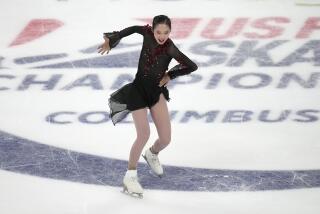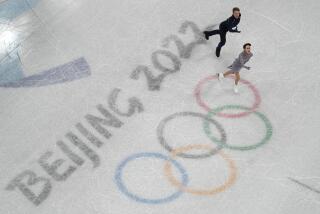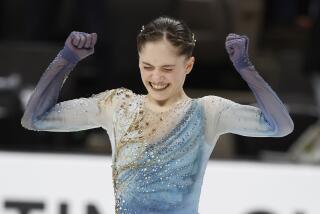They Seek Good Judgment
- Share via
KYOTO, Japan — Stung by the judging scandal that engulfed the pairs figure skating competition at the Salt Lake City Olympics, the International Skating Union is expected to adopt sweeping reforms of the sport’s scoring and judging systems this week during its Congress.
An ISU proposal outlined during the Winter Games by its president, Ottavio Cinquanta, would eliminate the traditional 6.0 perfect score in favor of a cumulative score based on the difficulty of elements performed. The judges’ panel would expand to 14 and a computer would randomly select seven scores to count toward the final tally, a change designed to eliminate bloc judging and deal-making.
Such radical ideas are evidence the ISU “recognizes the urgent need for changes to the existing system for selection of judges and the determination of results,” it said in a statement.
Canada, the U.S. and Australia have also submitted “urgent proposals.” Such initiatives need a four-fifths majority vote to be placed on the Congress’ agenda. To become part of the ISU Regulations, any proposal would need to be approved by a two-thirds majority of members attending.
The meetings, which will include elections for president, council members and technical committees, begin Monday morning.
Although usually resistant to change, the ISU is expected to adopt at least some reforms in response to the backlash generated by the discovery of improprieties in the judging of the Olympic pairs event and past improprieties among ice dance judges.
“I think it’s imperative on a number of levels that changes come out of this,” said Dick Pound, an influential member of the International Olympic Committee.
IOC President Jacques Rogge, who was angered by the Salt Lake City brouhaha, also wants an overhaul of the judging system. Rogge reaffirmed the autonomy of international federations in implementing the rules of their sports but said the IOC “calls for better rules and calls for a situation that would lead to far less controversy.”
French judge Marie-Reine Le Gougne’s claim she was pressured to vote a certain way by French ice sports federation head Didier Gailhaguet drew a spotlight to the deals and vote-swapping that have long undermined skating’s credibility. Le Gougne retracted her accusation, but the ISU suspended her and Gailhaguet for three years and banned them from the 2006 Olympics. Gailhaguet, however, was reelected president of the French ice sports federation last week.
Because the ISU determined Le Gougne acted improperly during the Games, the IOC awarded duplicate gold medals to Canadians Jamie Sale and David Pelletier, who were second to Russians Elena Berezhnaya and Anton Sikharulidze.
The world championships were also marred by controversy. About 20 ice dance couples signed a petition protesting the fourth-place finish of Lithuanians Margarita Drobiazko and Povilas Vanagas amid allegations the father of Israeli ice dancer Galit Chait had threatened a coach and skaters. Chait and Sergei Sakhnovsky won the bronze. The ISU rejected an appeal by the Lithuanians.
Veteran coach John Nicks is skeptical the proposed changes will make much difference.
“It seems to me it’s not the rules and regulations that need to change, it’s the sureness and character of the judges involved,” he said.
Ensuring panels are geographically balanced and judges are held accountable for their decisions is crucial to restoring credibility, said Paul Wylie, the 1992 men’s Olympic silver medalist and member of a group that helped shape part of the reform proposal backed by the U.S. Figure Skating Assn.
“The sport relies on the credibility of the judging system, and I think people look at the judging system and need to believe it’s for real,” he said. “When bias rules, it costs skaters, the stakeholders, a great deal.”
Wylie dislikes the ISU’s idea of scoring from 0 up instead of from 6.0 down. The ISU proposes setting up a Scale of Value for each element and requiring skaters to submit a plan of their programs, by element and by time. Skaters would get points for each element. Each skater or pair would also get a Grade of Execution, to be added to the Scale of Value points to form the technical score.
Each judge would also assign a presentation score, ranging from 0.1 to 6.0, based on basic skills and performance skills. That mark would be multiplied by a special factor to produce a presentation score, which would be added to the technical score.
“I don’t think additive scoring works,” Wylie said. “... There’s 41/2 minutes of figure skating to watch. You can’t sit and add in your head and also get a feel for presentation.”
The USFSA’s proposal would keep the 6.0 but would eliminate ordinals--each judge’s ranking of each skater--in favor of a median total score. It would also have a computer randomly select which judges’ marks would count.
“We’ve had people in our organization and statisticians say it was a very solid way to go about things,” said USFSA President Phyllis Howard, who leads the five-person U.S. delegation. “The median mark is a way to protect against judging blocs.”
The U.S. also proposes to ban for life any judge or federation official found guilty of unethical conduct. The ISU calls for two-year suspensions “in the case of a judge being responsible for evident and/or repeated anomalies.” An Australian proposal suggests a country whose judge is found guilty of misconduct in two consecutive seasons or three nonconsecutive seasons should lose its right to nominate a judge for events such as the Winter Olympics.
“I think there is an urgent need for reform,” said Howard, who is running for one of five figure skating spots on the 11-member ISU Council. “It’s critical to address that at this time.”
*
Times staff writer Alan Abrahamson contributed to this story.
*
(BEGIN TEXT OF INFOBOX)
*--* Reformation Project Key points of the figure skating judging reforms proposed for discussion at the International Skating Union Congress, Monday through Friday, at Kyoto, Japan: ISU PROPOSAL * Fourteen judges will grade skaters but a computer would randomly select seven anonymous votes to make up final scores * Cumulative point values would be awarded for technical elements and added to a presentation mark to produce total score * Marks of all judges and referees would be sealed until the end of the season, when they would be analyzed by computer for anomalies * Judges will have touch-screen computers and video replays. They would be compensated for their work at the end of the season U.S. PROPOSAL * Placements of skaters would be determined by a median mark. A computer would select seven of 10 judges’ scores (or five of eight on smaller panels) to calculate score * Judges’ panels would be geographically balanced. An ISU committee would determine the appropriate distribution among regions and number per region * Lifetime bans for advisors, judges, referees, federation officials or members of an ISU federation found guilty of misconduct or an ethical violation AUSTRALIAN PROPOSAL * Events would be judged by two groups of seven judges on opposite sides of the rink. The scores of nine randomly selected judges will count toward the results * The two highest and two lowest scores would be dropped. The remaining five would be counted by the computer to determine the results * Referees must be of a different nationality than the medal winners of the year before in the event in which they officiate CANADIAN PROPOSAL * Supports ISU proposal but suggests two years’ testing and evaluating before permanent adoption. Until then, judges’ panels would consist of 14 members, randomly drawn. Nine judges’ marks and ordinals will be used to calculate the final result * Lifetime ban for those found guilty of misconduct * Presidents of national federations could not serve as judges or referees
*--*
More to Read
Go beyond the scoreboard
Get the latest on L.A.'s teams in the daily Sports Report newsletter.
You may occasionally receive promotional content from the Los Angeles Times.







